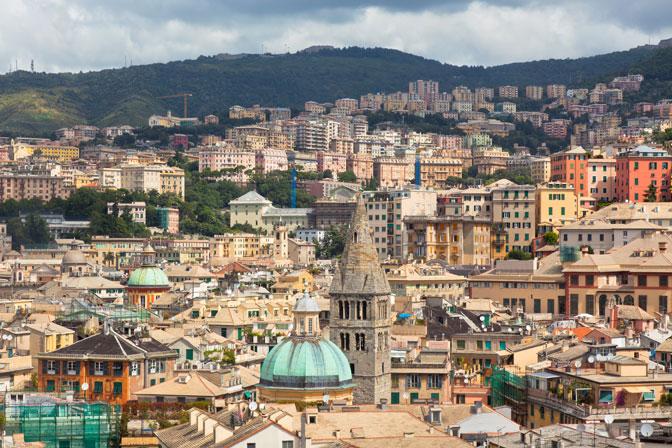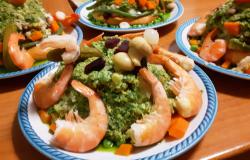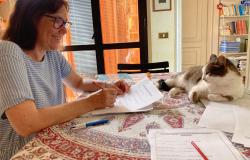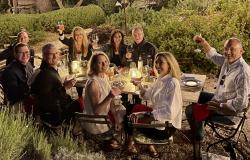Genoa does not yield up its charms easily, but to really know it is to love it. Teresa Fisher reports on a city of contrasts.
Picture this: a small, compact city, squeezed onto a narrow coastal plain on the western slopes of the Apennine Mountains, its stately buildings in every imagi-nable shade of terracotta, apricot, peach and cream rising up out of the sea and reflecting back the sunlight from the windows of over a hundred noble palaces – these were my first impressions, as I gazed from the aircraft, of the Mediterranean port of Genova, the birthplace of Christopher Columbus, jeans, pesto and focaccia bread.
Look more closely, and you’ll find that Genova is full of surprises. It is both an ancient port of dark, narrow streets and a lively, modern city with motorways tunnelling right into its very heart. Indeed, Genova is a mixture of the ugly and the stunningly beautiful, which over the centuries has caused mixed reactions from the countless luminaries who have resided here. To Wagner, it was ‘somewhere indescribably beautiful and grandiose’, and to Flaubert, ‘a beautiful town, a really beautiful town – everything is made of marble: stairs, balconies, palaces’, whereas Dante criticised its ‘sea without fish, hills without wood, men without honour, women without shame’, and Montesquieu considered it ‘detestable and boring’. Even Dickens remarked how ‘it abounds in the strangest contrasts; things that are picturesque, ugly, mean, magnificent, delightful and offensive, break upon the view at every turn – there seems to be always something to find out.’
Chattering locals, bustling shoppers
I began my discovery of Genova by exploring the famous carrugi, the maze of narrow, medieval streets and crooked alleyways in the city centre, flanked by dark, solid houses several storeys high. Looking up at the tiny ribbon of brilliant blue sky between the rooftops, I marvelled at the tolerance of the families who live facing one another with their windows little more than a metre or two apart. Down at street level, the lanes are filled with all the colourful and noisy activity of an ancient Mediterranean town - chattering locals, bustling shoppers - and the mingling of mouthwatering aromas emanating from the old-fashioned cafés, bakeries and grocers’ shops. But the most prevailing smell is that of the local speciality - pesto, the tasty green seasoning for pasta, made with basil, garlic, pinenuts and cheese, bound together with olive oil.

Carrugi - Genova
This area of Genova is filled with cosy bars, cafés and restaurants. For speciality pesto dishes, it’s hard to beat the small restaurant above the delicatessen Ao Vegio Carrogio in Via San Lorenzo, but my favourite spot is the sunny open-air café in Piazza Matteotti. Here, they not only serve a sensational tomato and mozzarella salad accompanied by authentic Genoese focaccia bread and washed down with local wine, but it is also ideal for people-watching, situated in the spacious square outside the recently renovated 17th-century Palazzo Ducale, which frequently hosts exhibitions and concerts. For dessert, head to Klainguti, a chandelier-lit Austrian-style tea salon in nearby Piazza Sozigli, where they still produce the hazelnut croissant known as a Falstaff - a favourite of Giuseppe Verdi, who spent 40 winters here in Genova. ‘Thanks for the Falstaff - it’s much better than mine!’ he once wrote. Scattered amidst the noble mansions, humble homes and intimate eateries of the ancient city centre are the beautiful churches of Genova. One of the city’s most noteworthy buildings is the thousand-year-old Cathedral of San Lorenzo, with its striking façade of tiered black and white marble. The statue of San Lorenzo holding a sundial, at the corner of the building, is known locally as ‘the knife-grinder’. The austere façade gives no idea of the majestic interior with its grandiose colonnades, gilded mouldings and frescoed ceilings. Hunt around and you will find a variety of amazing treasures including the relics of St John the Baptist, a lock of hair from the Virgin Mary, and even a piece of the crucifix.

Cathedral of San Lorenzo
Genova is undoubtedly a city to explore on foot - but it is not for the faint-hearted as everything is on a hill, and comfortable footwear is a defi-nite must! The entire city is organised vertically, with steep streets laid one above another, grand tree-lined avenues, shady parks and splendid terraces. The higher you go, the better the view of the city’s famous port.
Underwater trip
Through the centuries, Genova’s port has been the centre of its economic life. Little more than a fishing village in Roman times, it became a major trading port in the fifth century, frequented by Greek and Etruscan merchants. From 1097, it provided ships for the First Crusade and, by its medieval heyday, it had become a flourishing maritime republic that rivalled Venice for power. Today, its enormous port is a sprawling mass of cruise ships, ferries, tankers and container ships. Ship-building is still Genova’s major industry, and the city is Italy’s main port in volume of passengers and freight traffic, handling imports mainly of coal, crude oil and grain, and exports chiefly of cotton and silk textiles, olive oil and wine.

Renovated Old Port Area
Recently, the old port area has been renovated and is now a major attraction, including the creation of one of Europe’s largest aquariums - one of Italy’s most visited museums and a must-see for children, providing an underwater trip around the world. The old quay has been enlivened by chic cafés and restaurants, giant modern sculptures resembling sails, a new congress centre, and the Bigo, a large metal structure designed by local architect Rienzo Piano, co-creator of the Pompidou Centre in Paris, which contains a glass-sided lift providing fantastic bird’s-eye views of the area.
But far more potent than the 21st-century city symbols of aquariums and congress centres are the two diverse images of the port that immediately spring to mind: Christopher Columbus, the city’s most celebrated citizen who embodies the maritime tradition of the city, and jeans. It was the Genoese sailors who first gave the word ‘jeans’ to the heavy-duty trousers they wore. To learn more about the history of the port, call in to the Padiglione del Mare e della Navigazione, a museum tracing the city’s relationship with the sea, or climb aboard a 90-minute boat tour from outside the Aquarium (organised by the Port Boatmen’s Co-operative, telephone 010 265712), past shipyards and wharfs, and such landmarks as La Lanterna, a 16th-century lighthouse and symbol of the city, whose light beams up to 50 kilometres out to sea. It also presents a grand view of the city rising in tiers, and of the forts standing guard on the surrounding hills. Though a great naval power, the Republic of Genova needed to protect its shoulders, and during the 17th century it constructed 33 forts, the remains of which can be visited on foot starting from the end station of the Zecca-Righi funicular railway.

Zecca-Righi Funicular - Genova
Subtle beauty
Numerous museums and galleries reflect the city’s rich naval legacy, but it is the multitude of palaces which are the most exciting discoveries for its visitors. Unlike so many other Italian metropolises, Genova is not a showy city. There are surprisingly few grand thoroughfares or flamboyant piazze with splashy fountains. Its beauty is far more subtle than that, reflected in its many examples of fine medieval, Renaissance, Baroque and Gothic architecture.
Genova’s most outstanding buildings can be found along Via Garibaldi, a short, narrow strip consisting entirely of fine Renaissance palazzi, built between the 16th and 18th centuries when the great Genoese families were at their maximum wealth. Note the grandeur of the doorways and their handsome trompe-l’oeil painted facades, and the serenity of their inner gardens and courtyards. If you’re lucky you may catch a glimpse of the frescoes in their large reception rooms. Palazzo Bianco and Palazzo Rosso house museums of art by Genoese and Flemish artists, and a visit to the nearby Palazzo Spinola di Pellicceria, now home of the National Gallery, is recommended. It provides insight into the lifestyle and furnishings of these noble Genoese homes.

La Lanterna - Genova
It’s true. Genova is a city full of subtleties, contrasts and surprises. You either love it or you hate it. Many people have mixed reactions initially, but then they love it deeply as they start to appreciate its spirit and its character. Genova ‘the Superba’, ‘the Queen of the Sea’, ‘the City of Palaces’ is arguably Italy’s most unjustly unknown city. Charles Dickens was right: ‘It is a place that grows upon you every day! I will part from Genova with anything but a glad heart.’








